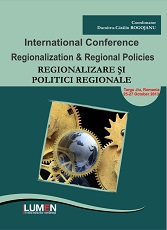Elemente de reper, modele şi opţiuni pentru proiectarea structurilor regionale administrative
Landmark elements, models and options for designing administrative regional structures
Author(s): Octavian Mândruţ, Denisa Ardelean
Subject(s): Politics / Political Sciences
Published by: Editura Lumen, Asociatia Lumen
Keywords: Regionalization; NUTS; spatial perspective; variants
Summary/Abstract: This paper seeks to approach the issue of regionalization in Romania, from a theoretical and predominantly spatial perspective. We believe that the elements of novelty in this endeavour are:a) assembling all regional levels (from NUTS1 to NUTS5) into a hierarchic and taxonomic structure of the national territory;b) constructing a different image from the predominantly “centralist” vision (from centre to periphery), to achieve an equipotential and equidistant vision;c) identifying and presenting some less evoked landmarks, such as entities with a certain spatial legitimacy: natural regions, integrated regions (both natural and human-made), historical and geographical regions, “countries”, “lands” (countryside) and elementary human communities;d) presenting an ordered, taxonomic and hierarchic system of current human communities (from capital cities to hamlets), as a basis for functional territorial systems with a gravitational behaviour;e) presenting some criteria for the analysis of similarities between current administrative entities and the spatial complementariness of those situated in reciprocal proximity;f) comparative analysis of spatial characteristics (natural, economic, demographic) between the previous regionalization (1968) and the current phase (2013), as a premise for reflecting on the evolution of administrative planning;g) elaborating variants (situated between constraints and objective possibilities), based on options resulting from the predominant use of a “central criterion”.The paper comprises an essential cartographic illustration and tables with significant secondary data.
Book: Regionalizare şi politici regionale
- Page Range: 87-133
- Page Count: 47
- Publication Year: 2014
- Language: Romanian
- Content File-PDF

